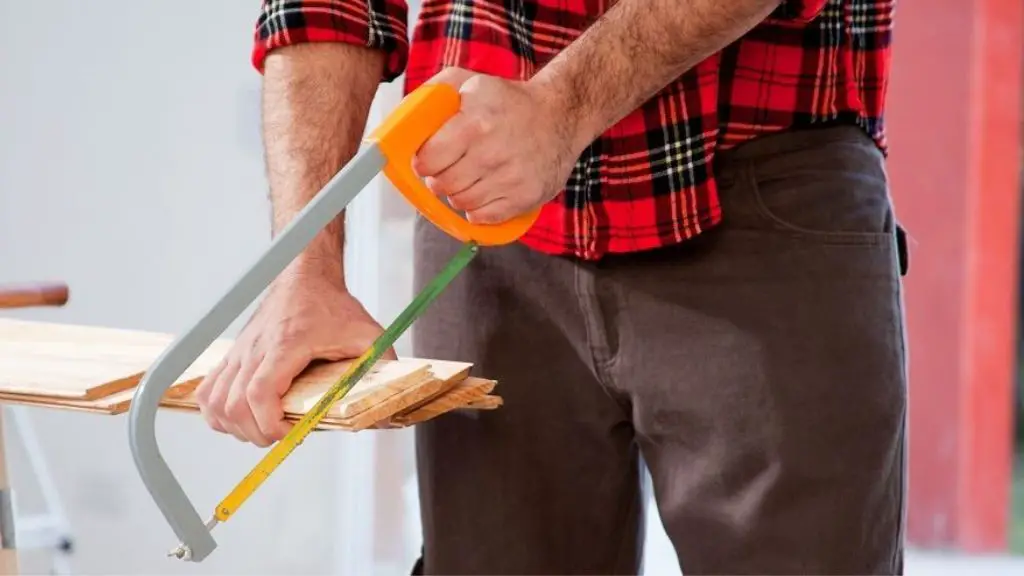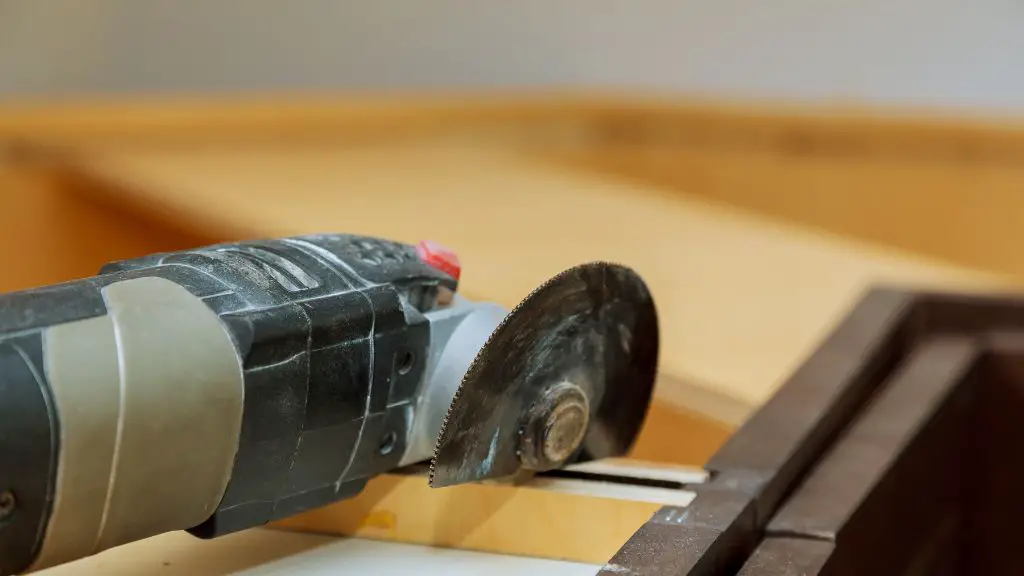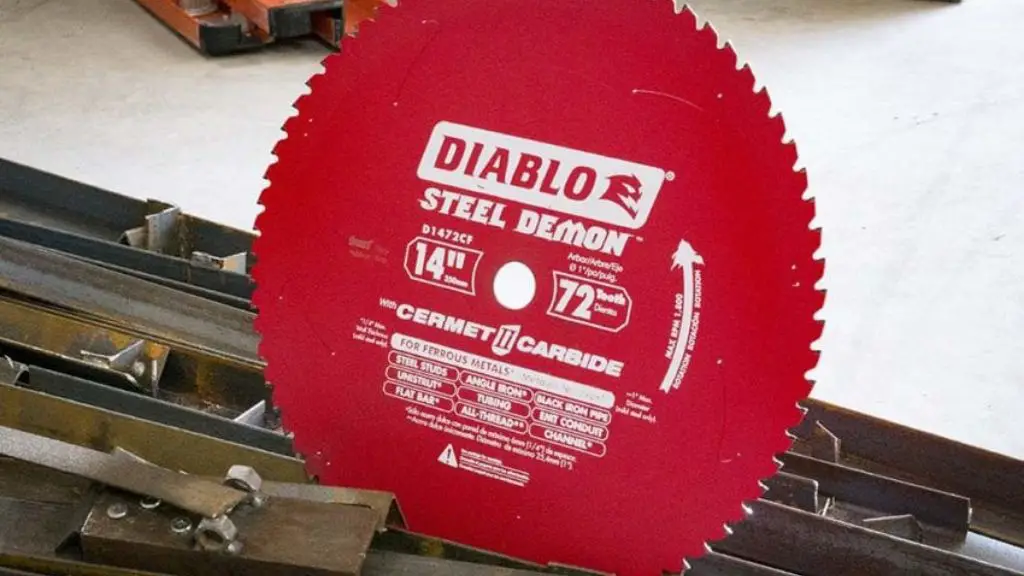Almost everybody who has a DIY kit is familiar with the hacksaw. It is a pretty versatile tool that can be used to cut many different types of materials. One of the most common materials that everybody cuts is wood, and it’s good to know if you can use a hacksaw to cut wood.
You can use a hacksaw to cut wood. However, it is not the best course of action as the hacksaw is better suited for plastics and metal sheets. Still, if you know how to properly do it, you can cut wood with a hacksaw without any problems.
We shall discuss the reasons a hacksaw is not ideal for cutting wood And how you can use it. Also, we’ll look at the best tools you can use for wood cutting and the best uses of a hacksaw. Let’s go!
Can you cut wood with a hacksaw?
The hacksaw is a pretty popular home DIY tool for all cutting tasks. They can cut through various metals like Aluminum, steel, and even iron. Of course, any tool that can cut these hard metals should be able to cut wood that is softer without issues. However, it is often not advised that you use your hacksaw to cut wood.
There are a few reasons for this and they are:
The position of the teeth:
Because the hacksaw is meant for cutting metals and plastics, the teeth are closer together than those of saws meant for wood. Using the hacksaw for cutting wood, therefore, makes the teeth get clogged with sawdust and makes cutting extremely difficult.
It can render the hacksaw useless for other materials:
If you use your hacksaw to cut wood consistently, the teeth will get ruined by the wood. This will make it useless for cutting materials like plastic that the hacksaw is meant for.
It involves greater physical effort:
Another point against using the hacksaw to cut wood is that you will need to apply far more pressure to be able to do any cutting. Because the hacksaw is entirely manual and is so closely toothed, you will have to force it to cut wood at all.
The hacksaw can easily get caught in the wood:
Another reason you should avoid using your hacksaw to cut wood is that the tool can easily get stuck in the wood. This is because of the fundamental differences between the materials it is meant to cut and wood.
However, this doesn’t mean that you can’t use the hacksaw to cut wood at all. Yes, you can but you have to be very careful with one. One of the most important things to note before cutting wood with the hacksaw is the type of balder that is featured on the saw. This will be discussed in a later section.
Best saws for cutting wood
Any task you want to do is best carried out by using the best tool for the job. This is to prevent any safety issues or shoddy jobs that could arise if you use a tool that isn’t ideal for the task. As discussed previously, you can use a hacksaw to cut wood. However, it is not advisable for the reasons mentioned.
Because of this, let’s look at the best tools you should have in your yard if you’ll be doing any wood-cutting tasks in the future.
Hand saw:
This is a manual-powered saw that features teeth just like the hacksaw. One difference between them, though, is that the handsaw doesn’t have a frame like a hacksaw and is made of the blade all through. The handsaw is best for cutting small pieces of wood because of how tedious it would be to cut large pieces with a manual tool like the handsaw.
Miter saw:
This saw is the ideal tool for making accurate cuts into the wood. They are fixed onto the working table and are best for cutting long boards or wood. They are very precise in their cuts, but can only make cross cuts.
Circular Saw:
The circular saw is similar to the miter saw, but with certain crucial differences. One is that the miter saw is more accurate because it is fixed on the table while the circular saw is handheld. Also, circular saws can make both cross cuts across the width of the board and rip cuts across the length. Circular saws are cheaper and will be a better return on investment if you aren’t a woodworking professional.
Table Saw:
Also known as the saw bench or bench saw, the table saw features a circular saw blade that is mounted on a mandrel and is driven by an electric motor. It is a very versatile tool that can be used to make cuts in any direction, either rip cuts or cross cuts.
These are the best types of saws you should use on a wood-cutting project.
What to use a hacksaw for
Having seen that the hacksaw isn’t best for cutting wood, what is it ideal for then? Professionals like plumbers and electricians are those that most often use hacksaws. The materials they are used fo cut are:
Plastics:
Whatever the size of the plastic, you can easily use a hacksaw to cut it without any issues. The only problem you can run into is the stress of using a hacksaw to cut a big piece of plastic or holding the plastic down for cutting.
Metals:
Hacksaws can also cut pieces of metals like Aluminum and steel. However, you can only use a hacksaw to cut smaller pieces of metal as cutting big metals with a hacksaw would be quite a task. The most suitable type of metal is small to a medium-sized metal rod.
Tubing:
You can also use a hacksaw to cut any type of tubing, be it plastic or metal
Wood:
Lastly, you can use a hacksaw to cut minor pieces of wood. As discussed, it is not ideal for the task but you can very well use it if you are hard-pressed to do so.
These are the materials you can use the hacksaw to work on.
Types of hacksaw blades
One of the main points that will determine if you will be able to use your hacksaw to cut wood is the kind of blade that is on it. Some blades work well with any type of material while some only work with specific materials. The types of blades are:
Flexible blades:
These types of blades only have their teeth reinforced. As the name suggests, they are very flexible and ideal for cutting plastic pipes and thin sheets of metal. You should avoid using this on wood as it will be easily ruined.
Medium grade blade:
This is a more powerful type of hacksaw blade and they often come with twenty to twenty teeth per inch on the blade. They are used for cutting stronger materials like brass, high carbon steel, and even cast iron. You can use a medium-grade blade to cut wood but it will be a poorly efficient job.
Superfine grade blade:
With thirty to thirty-two teeth per inch on the blade, the superfine grade blade is ideal for cutting both light and heavy metals. However, because of this very high number of teeth, you shouldn’t use it to cut wood of any kind.
Coarse grade blade:
This kind of blade comes with fourteen to eighteen teeth per inch on the blade. It is inferior to both superfine grade blades and medium grade blades and it is best used for cutting lighter metals like Aluminum and copper. This is the best you can use to cut wood because it has the least number of teeth while being strong enough.
If you can get a blade that has as low as eight teeth per inch, that would be ideal for cutting. Sadly, these types of blades are very rare.
Safety Considerations In Using A Hacksaw
Whatever kind of material you are working on, you have to follow proper safety precautions when using the hacksaw. This is to avoid any injuries that might arise from improper use of the tool. Some of these precautions are:
Keep parts of the body from the saw while cutting:
Even if the pressure being applied is minimal, always avoid placing any part of the body of a human or animal beneath the teeth of the hacksaw. Doing this increases the risk of a freak accident occurring.
Ensure that the hacksaw is properly tensioned:
If the blade is not well secured on the hacksaw, it might fall off during the cutting and lead to serious injuries. Ensure that it is well and properly fastened to avoid this issue.
Conclusion
The most popular DIY cutting tool would be expected to easily cut the most popular cutting material—wood. However, this is just not true. Hacksaws are versatile enough that you can use them to cut wood but they are not well suited for the task. Using a hacksaw to cut wood is tedious and can also ruin the teeth of the saw, especially in the long run. That being said, you can always utilize the hacksaw to cut wood if it’s just a one-time thing.

I have always loved sawing and cutting. I started doing it when I was a kid and never stopped. I love the feel of the wood beneath my hands, the smell of the sawdust, and the satisfaction of creating something beautiful.
I’ve been writing for quite some time now and thoroughly enjoy sharing my passion with others. I’ve written for both online and offline publications – such as Amazon and Medium.




